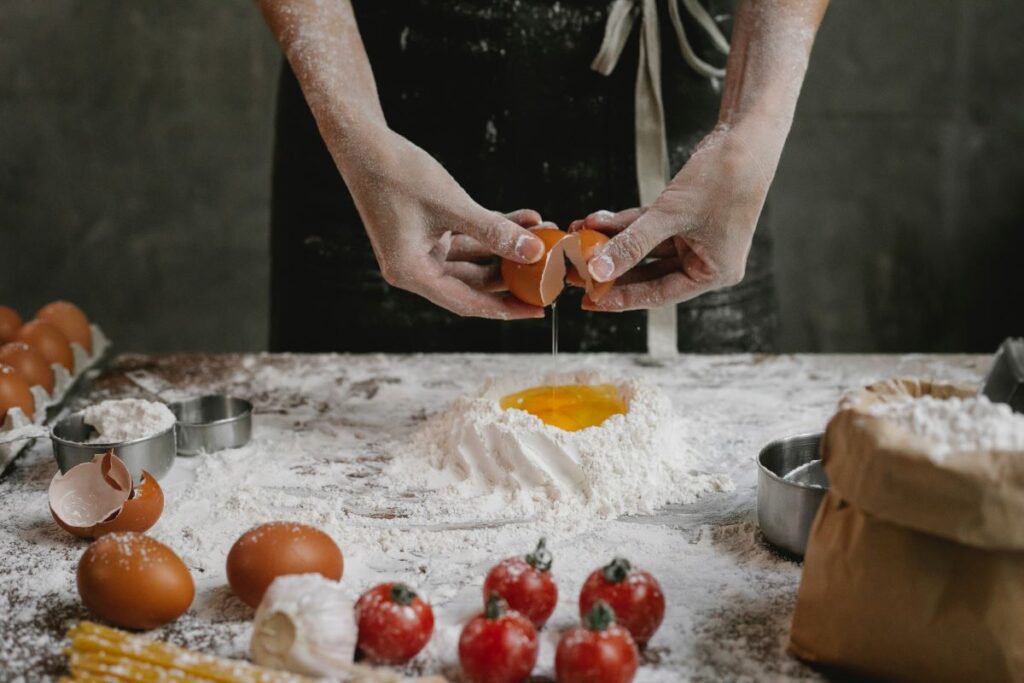Stuck for family recipe book ideas because collecting and organizing it all seems daunting? We know that compiling favorite family foods and traditions into a family cookbook is about more than just preserving the dishes we have come to love; it’s truly a way of connecting with our heritage and culture. Family recipes passed down through the generations can evoke memories, emotions, and a sense of belonging. They can also teach us about our ancestors, their lives, and their traditions. Yet embedded in wonderful memories, you may also find sadness and loss and hardship. So, while the thought of creating that cookbook may be exciting, the feelings evoked when tackling the project can make the process a little more challenging than expected.
Don’t let that stop you! In this article, we will explore the importance of preserving and sharing these culinary legacies. We will provide tips on how to start your own recipe preservation project and offer family recipe book ideas. Learn how to record and preserve your family recipes, how to share them with others, and ways to truly appreciate the joy of reviving heritage cuisine. Whether you have a treasure trove of family recipes or just a few favorites, this article will inspire you to embark on a delicious journey into your ancestral food heritage.
The Stories Family Recipes Tell

Family recipes are a gateway to the past. They can reveal a lot about our family history, such as where your ancestors came from, what they ate, how they cooked, and what occasions they celebrated. They can also reflect the influences of different cultures, regions, and times. For example, you may find recipes that use ingredients or techniques from other countries, or that adapt to local availability or preferences.
Food traditions can also carry the stories and traditions of generations. They can tell us about the people who created them, their personalities, their values, and their experiences. Emotions and sentiments of different moments in history, such as joy, sorrow, hardship, or resilience may be part of the recipe. Your family may have recipes that were made for weddings, funerals, holidays, special occasions like births or anniversaries, or during economic hard times and even wartime.
One way to learn more about the heritage of your family recipes is to share personal anecdotes or stories related to them. You may have heard stories from your parents, grandparents, or other relatives about how they learned to cook certain dishes, who taught them, what occasions they made them for, or what memories they associate with them. Do you have your own stories to tell about cooking or eating these recipes with your family or friends? Sharing these stories can enrich your understanding and appreciation of your family recipes.
Family Recipe Book Ideas: Unearthing the Recipes
If you are interested in preserving your family recipes, the first step is to start collecting them. You may already have some recipes written down in notebooks, cards, or scraps of paper. You may also have some recipes stored in your memory or in digital formats. However, you may not have all the recipes you want or need. You may be missing some ingredients, measurements, instructions, or variations. You may also be unaware of some recipes that exist in your family.
One way to fill in the gaps is to reach out to your family members for their favorite recipes. You may be surprised by how many recipes they have or know. Other family members may discover new dishes that they have never tried or heard of before. Ask your family members to share their recipes with you by phone, email, text, or social media. You can also send them photos of your recipes and ask them to do the same.

Another way to collect more recipes is to organize a family gathering or virtual session where you can cook and share these dishes together. This can be a fun and meaningful way to reconnect with your family and learn more about their recipes. You can ask each family member to bring or make a dish that has a special significance for them or for the family. You can then enjoy a feast of family flavors and exchange recipes and stories.
Family Recipe Book Ideas: Recording and Preserving Recipes
Once you have collected your family recipes, the next step is to record and preserve them. There are various methods of recording family recipes, depending on your preference and convenience. One method is to write down your recipes by hand on paper or cards. This can be a simple and personal way to record your recipes.
Old School Methods
- Family Recipe Book: There are a ton of old-school blank cookbook products that allow you to write in your own recipes and organize them with tabs and stickers. These typically are geared just for saving recipes. It is a great gift idea for wife, mom, or women who love cooking and preserving family recipes.
- Family Recipe Scrapbook: A recipe scrapbook lets you record and preserve your family recipes with photos and stories. It is a beautiful way to create a family heirloom and celebrate your heritage and culture.
- Family Cookbook Recipe Journal: A recipe journal is another easy way to collect family favorites and also add your personal reflections along the way. Many recipe journals have themes, prompts, and tips for writing and cooking. It is a simple and practical way to keep track of your family recipes, as well as chronicle your personal journey while doing so.
- Recipe Box: This is a container that holds recipe cards or clippings. You can store and organize your recipes in a convenient and stylish way. Some recipe boxes come with cards, dividers, and other accessories.
- Recipe Binder: This is a binder that holds full-page recipes or recipe cards in page protectors. You can sort and label your recipes by categories, and easily add or remove pages as needed. Some recipe binders come with cards, dividers, labels, magnetic pages, and other accessories.
Digital and Online Methods
Another method is to digitize your recipes by scanning, typing, or photographing them. This can be a more secure and convenient way to record your recipes. You can store your digital files on your computer, phone, cloud service, or external drive. You can also use online tools such as websites, apps, or software that allow you to create and organize your own digital cookbook. Here are some popular products and services to consider:
Family Cookbook Maker: This is software that helps you create and publish your own cookbook with your family recipes. You can invite family members to contribute, customize the layout and design, and order printed copies or sell them online.
Cook’n Recipe Organizer: This is a software that helps you find and capture internet recipes, organize and categorize them, create menu plans, make shopping lists, print family cookbooks, analyze nutrition, and more.
Recipe Keeper: This is an all-in-one recipe organizer, shopping list, and meal planner available across all your devices. It’s also an Amazon Alexa skill that allows you to search your recipes, add items to your shopping list, and cook hands-free with step-by-step instructions (English language only).
Recipe Card Cookbook: What could be easier than snapping pics of your family recipe cards, uploading them to a website, selecting a cover and page layout (or create your own), writing an introduction, and then placing an order for your finished cookbook? RecipeCardCookbook.com can take you from a box of card to a beautiful cookbook to share with others in no time at all.
Create My Cookbook: Want to do it all online and the option for getting a little help with your project? Create My Cookbook offers a comprehensive service for storing, creating, viewing, and printing cookbooks for a variety of applications. Don’t want to translate those handwritten recipes to digital form or worry about design or errors? Create My Cookbook’s design services and “WeTypeIt” “WeReviewIt” services can help you complete your family recipe book project with ease.
Whichever method you choose, it is important to preserve the original copies of your family recipes as well. These copies may have sentimental value or historical significance for you and your family. They may also contain handwritten notes, comments, stains, or signatures that add character and charm to your recipes. You can store these copies in a safe place such as a box, binder, album, or frame.
Sharing the Culinary Legacy
After recording and preserving your family recipes, the next step is to share them with others. Sharing your family recipes can be a wonderful way to celebrate and honor your heritage and culture. It can also be a way to connect and communicate with your extended family members and the wider community. You may find that your family recipes have similarities or differences with other families’ recipes. By sharing time honored food traditions, you may spark curiosity or interest in others.
There are many creative ways to share your family recipes, depending on your audience and purpose. One way is to create a family cookbook or blog that showcases your recipes, stories, and photos. You can print or publish your cookbook or blog online and distribute it to your family members and friends. You can also sell or donate it to libraries, schools, museums, or charities.
Another way is to host or participate in events or activities that feature your family recipes. You can organize or join a potluck, picnic, dinner party, or cooking class where you can cook and share your dishes with others. You can also enter or attend a contest, festival, fair, or exhibition where you can display and demonstrate your recipes to a larger audience.
The Joy of Reviving Heritage Cuisine
The final and most rewarding step of preserving and sharing your family recipes is to savor the joys of reviving heritage cuisine. Cooking and sharing these recipes with your family and friends can bring you happiness, satisfaction, and fulfillment. Go ahead! Dive into the nostalgia and connection that comes from recreating ancestral dishes that have been loved and cherished for generations. You may also discover new flavors, techniques, and combinations that can inspire and delight you.
Preserving and sharing your family recipes can also enrich your life in many ways. You can learn more about yourself, your family, and your culture through these recipes. Projects like this are a great platform for self- expression. They can fuel creativity and provide an excellent bridge to family relationship building. By contributing to the preservation and promotion of your heritage and culture, you are creating a bridge to past and future generations.
We hope that this article has inspired you to embark on your own culinary journey of preserving and sharing your family recipes. Whether you have a few or many recipes to preserve, whether you share them with a few or many people, whether you cook them occasionally or frequently, we encourage you to embrace and celebrate the rich tapestry of family culinary traditions that make up our diverse and delicious world.
As an Amazon Associate I earn from qualifying purchases.


